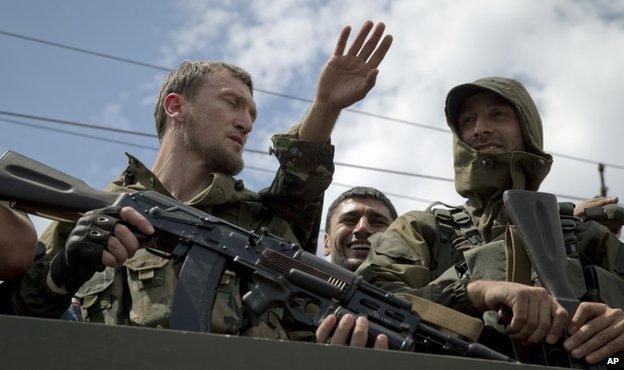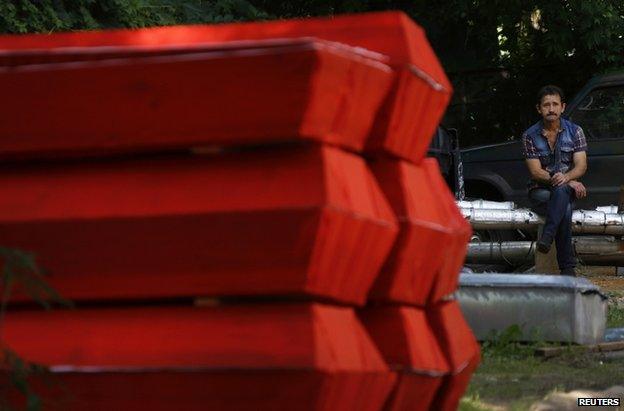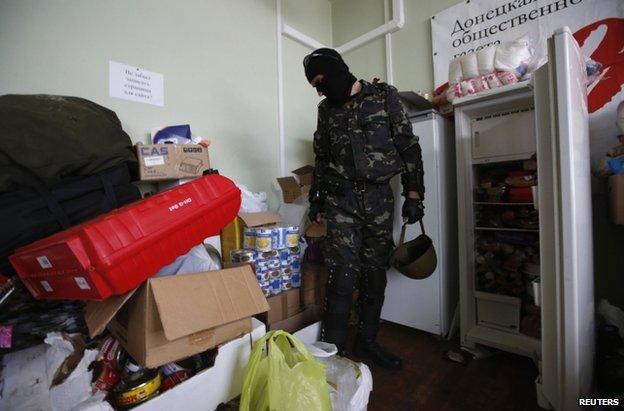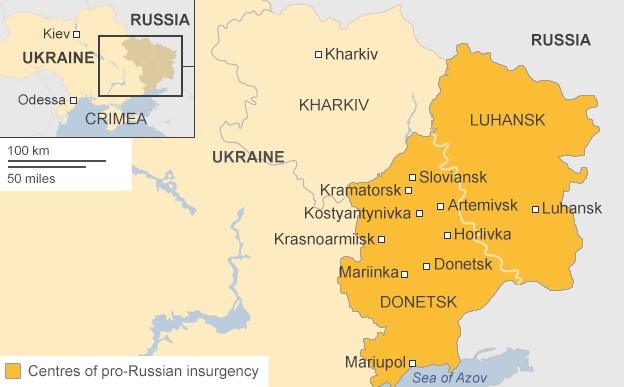Is Russia orchestrating east Ukraine violence?
- Published

Pro-separatist gunmen in Donetsk city centre on 25 May
Russia is widely accused of orchestrating the separatist insurgency in Ukraine's eastern provinces despite the Kremlin's attempts to portray it as a home-grown movement and its repeated denials of involvement.
After two months of fighting and the loss of hundreds of lives, Moscow's strong propaganda campaign against the new leadership in Kiev now comes with mounting evidence of Russian military engagement in the two provinces just across its border, Donetsk and Luhansk.

Is Russia arming the insurgency?

Militants with armour and artillery in Donetsk, 29 May
After militants downed another helicopter on 29 May, killing the general responsible for training Ukraine's new National Guard in combat, Washington said it was concerned about the separatists' continuing "access to advanced weaponry and other assistance from the outside".
The implication is that Russia or forces in Russia are supplying the heavily armed militants, who are known to have anti-aircraft artillery and armoured troop carriers in their arsenal, as this photo by the BBC's Will Vernon shows, external.
Kiev said the militants had used a portable air defence missile to down the helicopter - not evidence of Russian involvement in itself, however, as the Ukrainian army possesses similar weapons and rebels have seized weapons from the army before.
According to the government, weapons found after the fighting at Donetsk airport on 26 May had clearly been brought in from Russia.

Are there Russian boots on the ground?

Coffins for dead Russian militants in Donetsk, 29 May
One of the most telling episodes of the conflict was the killing of a large group of militants in a government attack on their lorry during the airport fighting.
At least 30 coffins were later dispatched across the border to Russia, with separatists describing the dead as "volunteers from Russia".
The presence of "volunteers", such as Cossacks from southern Russia, has been an open secret for months and echoes the situation in Crimea in March, before Russia annexed the territory from Ukraine.
Whether they are volunteers, mercenaries or soldiers on a covert mission, the suggestion now is that Russian involvement in eastern Ukraine is much more organised.

What is the Vostok Battalion?

Vostok fighters showing goods they say were looted in Donetsk on 29 May
The airport attack brought to light the presence in Donetsk of a well-equipped, close-knit military unit operating on the separatist side.
They call themselves the Vostok Battalion (English: East Battalion), which is the name of a former ethnic Chechen special forces unit commanded by Russian officers.
It once fought for Moscow against rebels in the Russian republic of Chechnya, and later served in the war against Georgia over South Ossetia in 2008.
Political pressure forced the dissolution of the old Vostok but, as regional security analyst Mark Galeotti argues in a recent blog post, external, it may have been reformed for covert tasks in Ukraine.
Their value to the separatists as a military unit is clear but they have also reportedly been cracking down on looters among the rebels, ostensibly trying to instil greater discipline.

Who are the Chechens fighting in Ukraine?
People who appeared to be Chechens were seen amongst rebel fighters
Vostok members confirmed for the BBC's Olga Ivshina that Chechens and Ossetians had taken part in recent fighting in Donetsk. They refused to say whether they were volunteers or had been under orders to deploy to Ukraine.
"Ramzan asked us to go so we went," one militant told another reporter, in apparent reference to Chechnya's hard-line pro-Moscow President, Ramzan Kadyrov.
But Mr Kadyrov has distanced himself from the conflict, while not denying that Chechens, who are Russian citizens of course, might be involved there without his knowledge.
The appearance of Chechens, with their reputation as formidable fighters and experts in urban warfare, adds a new dimension to the conflict, which has yet to see Ukrainian ground forces try to regain control of Donetsk, a city of nearly one million people.

Can Russians circulate freely in eastern Ukraine?

Vostok fighters aboard a troop carrier with a Russian flag in Donetsk on 25 May
Ukraine's control over its frontier with Russia appears to have broken down in the east. Just across the border, Russia had until recently a large military force, fuelling fears of an actual invasion.
One border town in Luhansk, Antratsyt (named after the anthracite mined locally) is said to be a key hub for the traffic in Russian fighters and weapons. The arrival of what was said to be a column of Cossacks from Russia in early May was captured on video , externaland posted on YouTube.
A resident of the town, who did not want to be named, told BBC News that Ukrainian authorities had given up trying to control the situation.
However, Ukrainian forces appear to have been taking action elsewhere in Luhansk. There are reports of a clash between border guards and a large incoming Russian convoy - reportedly 40 lorries - in the Dmytrivka area on 27 May.

But there must be local people among the separatists too...
Two key figures in the self-declared Donetsk People's Republic are both Russian citizens - defence minister Igor Girkin, whose nom de guerre is Strelkov, and prime minister Alexander Borodai.
But other leaders of the separatist movement like Pavel Gubarev, the rebel governor of Donetsk Region, and Denys Pushylin, speaker of the Donetsk rebels' parliament, are very much from the region.
And local men have also been killed fighting for the separatist cause in the east, as this YouTube video of a recent funeral, external shows.

